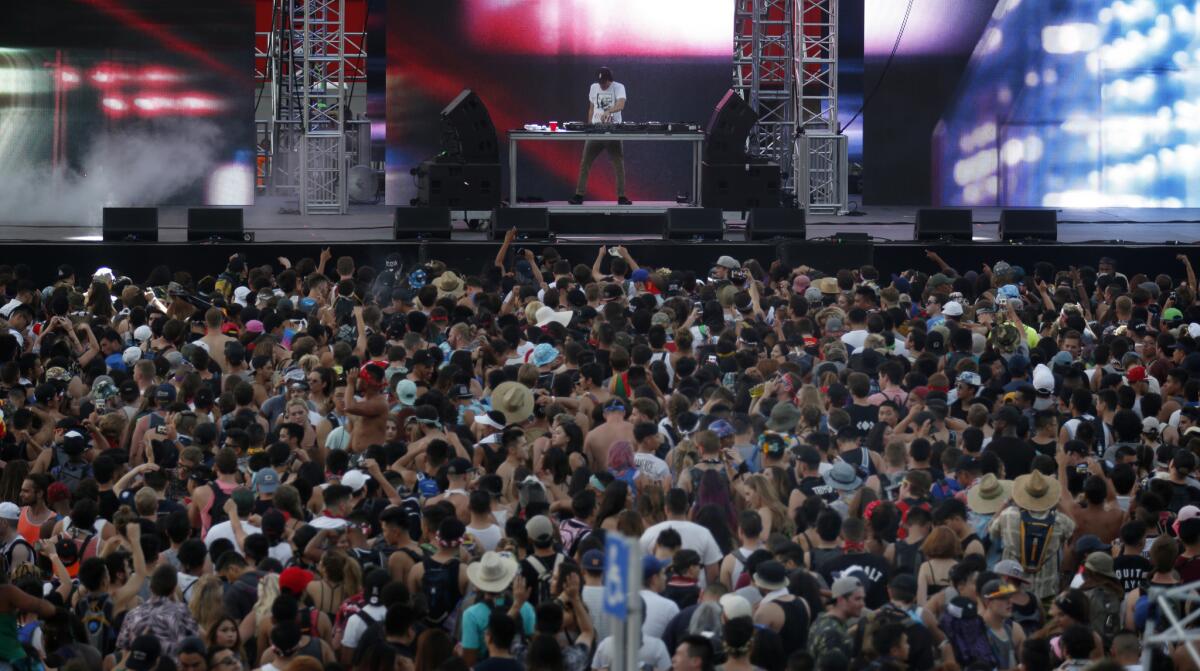Tragedy once again calls into question Hard Summer’s future

It’s a tragedy that now seems to happen every summer — young fans dying at large electronic music festivals in and around Southern California.
This year, three fans passed away at Hard Summer at its new location at the Auto Club Speedway in Fontana. While their exact causes of death are pending, they follow two fan deaths at the Pomona Fairplex, which were linked to drug use and heatstroke, at last year’s Hard Summer
All underline what has become a seasonal struggle in live music production.
It’s getting harder to deny that a mix of a very young fanbase — Nielsen estimates that more than half of EDM (electronic dance music) fans are under the age of 24 — scorching summer temperatures and the potential for illegal drug abuse results in a volatile combination.
But pinpointing the problems to a specific concert promoter or genre of music isn’t so cut and dry, especially in a musically diverse, multibillion-dollar music scene that has long outgrown its outlaw roots.
Some say the solution to such tragedies lies in treating drug use as more of a medical concern rather than a criminal one.
Still, some government officials see no room for any more debate.
“While the cause of these deaths is unknown at this time, we know that illegal drug use is rampant at these events and that many young lives have been lost because of drug use at raves,” said San Bernardino County Supervisor Janice Rutherford, an advocate for banning dance music events at the San Manuel Amphitheater in nearby Devore.
“The short-term economic benefits of these events do not outweigh the impacts … and they certainly do not warrant putting more young lives at risk.”
Government scrutiny of these events has grown every year, beginning with the outcry in 2010 after the drug-related death of a 15-year-old fan who attended what was then the Los Angeles edition of the Electric Daisy Carnival.
While intoxication is a problem at any mega festival or concert — a recent Kenny Chesney performance in Pittsburgh drew national headlines for its treatment of over-intoxicated fans — not all festivals have the same dilemmas. Only two deaths, for instance, have been reported at Coachella since 2008, and one was a traffic fatality.
Hard Summer founder Gary Richards, in an interview prior to this weekend’s event — representatives declined a request for a follow-up — defended his company’s practices.
“At the end of the day, we do everything we can do,” he said. “The biggest difference this year is that we’re creating even more awareness.”
He mentioned the addition of fan-assistance teams such as Hard’s Stand Up and Dance crew, who are “young adults who walk around with ice packs and water, looking for people who need help and can see if they’re having a situation,” and he noted the importance of personal responsibility.
“It comes down to the patrons,” Richards said. “They have to be responsible for their own actions. It all starts at the entrance of the festival — we have K-9 units, searches, you can’t bring in backpacks. We’ve got a system in place, but if people want to be stupid, they’re going to be stupid. We have to educate everyone, but there’s only so much you can do as promoter.”
If it’s time for a fundamental rethink of safety at these festivals, it’s not yet clear what new options promoters can legally take.
Measures like free water, cooling stations and the Stand Up and Dance team have become standard, as have vigorous security checks and on-site drug patrols from police. This weekend, 370 sheriff’s deputies and 240 other security personnel were working Hard Summer, and there were about 325 arrests at Hard Summer, mostly on narcotics charges.
In the wake of these deaths, some officials like Rutherford have suggested banning raves entirely from public property (though the Auto Club Speedway is owned by a private company, International Speedway Corp.). The L.A. Coliseum did so after the 2010 EDC, from the L.A.-based promoter Insomniac, and the Fairplex said it had no plans to host new ones after the two Hard Events festivals in 2015 (the family of one of last year’s victims is suing, among others, the festival’s parent company, Live Nation, and L.A. County).
L.A. County supervisors stopped short of an all-out rave ban on county property this year. San Bernardino County supervisors had considered a similar ban but so far have decided against it.
But this year’s Hard Summer underscored the potential difficulty in deciding what would, exactly, constitute a “rave.” The headliners — rapper ice Cube and the pop-dancehall group Major Lazer — each also played major slots at Coachella and have little to do with the pounding house and techno music traditionally associated with raving.
Other major Hard Summer acts like DJ Khaled, Ty Dolla Sign and Anderson .Paak are staples on hip-hop and R&B radio.
Even if venues decided to ban raves, it’s unclear if they would be banning specific concert promoters (Live Nation is by far the nation’s largest), particular styles of music or any large outdoor DJ-driven concert — and how those rules might be sidestepped.
After the recent backlash from L.A.-area governments, festivals like Hard Summer and EDC have since moved to other outlying cities, which may be less equipped to deal with the particular challenges of hosting large EDM events.
Whatever combination of strategies promoters are currently using, best-practices or not, is not currently sufficient to prevent deaths.
“Treating this as a criminal issue simply isn’t working to reduce either the number of users or the number of adverse medical incidents and deaths related to drugs,” said Mitchell Gomez, national outreach director for DanceSafe, an advocacy group that provides medical education and on-site drug testing at music festivals.
Even Hard’s Richards admitted that there’s more he’d like to do with education, such as on-site drug testing provided by the likes of organizations like DanceSafe.
“Everyone knows we should have it, but the law says we’re not allowed to. That’s the last piece of the equation to add to safety,” he said.
Many promoters feel threatened by the 2003 Illicit Drug Anti-Proliferation Act (commonly known as the Rave Act), a federal law that could potentially hold promoters liable for on-site activity seen as allowing or even acknowledging drug use inside.
But until promoters, governments and fans have an honest conversation about comprehensive and non-judgmental drug education at festivals, it’s likely that tragedies will continue to happen, regardless of any potential ban on raves.
“If harm reduction doesn’t become the norm at events, we won’t have any events,” said Missi Wooldridge, the founder of Healthy Nightlife, a firm that consults with music festivals on safety practices and fan education about drug use.
“The drastic answer will be to ban events, which won’t keep young people any safer and it definitely won’t end drug use. It will only push it back into the underground.”
MORE ENTERTAINMENT NEWS
Jimmy Fallon to host 2017 Golden Globe Awards
‘The Bachelorette’ finally asks the important question: How does NFL pro Aaron Rodgers feel?
More to Read
The biggest entertainment stories
Get our big stories about Hollywood, film, television, music, arts, culture and more right in your inbox as soon as they publish.
You may occasionally receive promotional content from the Los Angeles Times.







